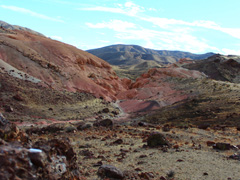BLM Extends Land Withdrawal for Red Rock Canyon State Park
Organization:
BLM Office:
Media Contact:
 SACRAMENTO, Calif. – The Bureau of Land Management (BLM) has extended the land withdrawal for Red Rock Canyon State Park in Kern County to authorize the continued management of the site as provided by the Memorandum of Understanding between the BLM and the California Department of Parks and Recreation.
SACRAMENTO, Calif. – The Bureau of Land Management (BLM) has extended the land withdrawal for Red Rock Canyon State Park in Kern County to authorize the continued management of the site as provided by the Memorandum of Understanding between the BLM and the California Department of Parks and Recreation.
The land withdrawal extension granted on May 12, 2017, allows for approximately 800 acres of public lands at Red Rock Canyon State Park to be withdrawn from all public land and mineral laws for a period of 20 years, except conveyances under Section 701 of the California Desert Protection Act of 1994. The extension was granted to protect the park resources of the lands until the lands can be conveyed to the State of California as mandated by Congress.
Red Rock Canyon State has approximately 15 active mining claims. The withdrawal made by the order does not alter the applicability of those public land laws governing the use of the lands under lease, license, or permit, or governing the disposal of their vegetative resources.
As stewards, the BLM manages public lands for the benefit of current and future generations, supporting conservation in pursue of its multiple-use mission. The BLM believes partnerships and inclusion are vital to managing sustainable, working public lands.
The Federal Register notice can be viewed online at https://www.federalregister.gov/documents/2017/05/22/2017-10357/public-land-order-no-7862-extension-of-public-land-order-no-7260-red-rock-canyon-state-park.
The BLM manages about 245 million acres of public land located primarily in 12 western states, including Alaska, on behalf of the American people. The BLM also administers 700 million acres of sub-surface mineral estate throughout the nation. Our mission is to sustain the health, diversity, and productivity of America’s public lands for the use and enjoyment of present and future generations.
